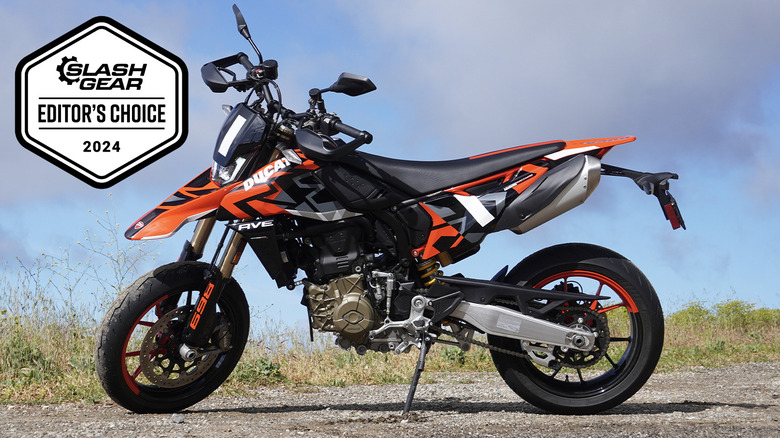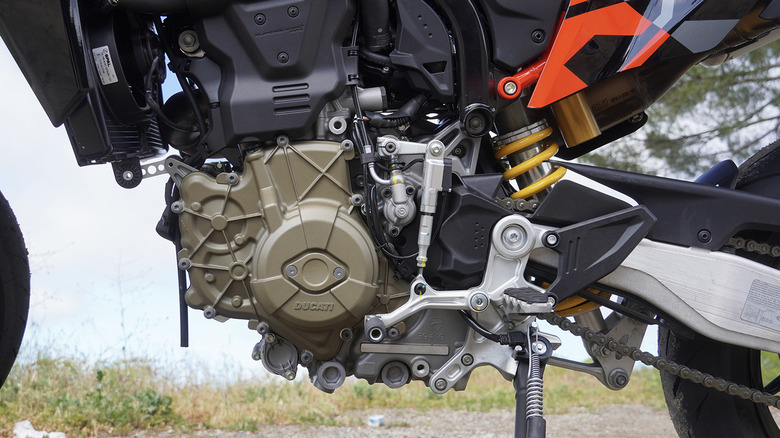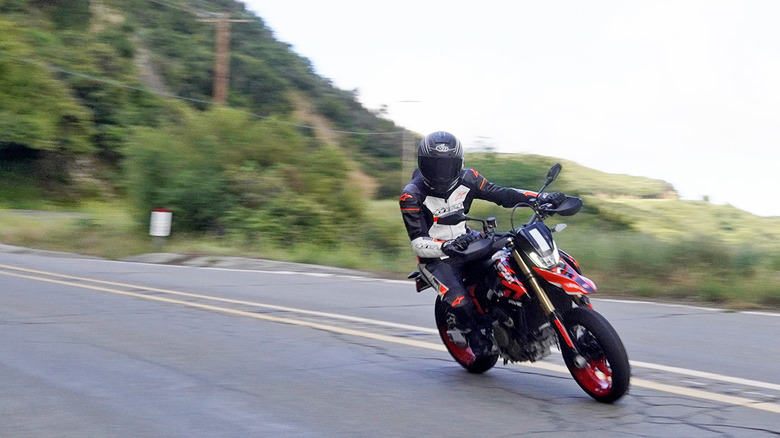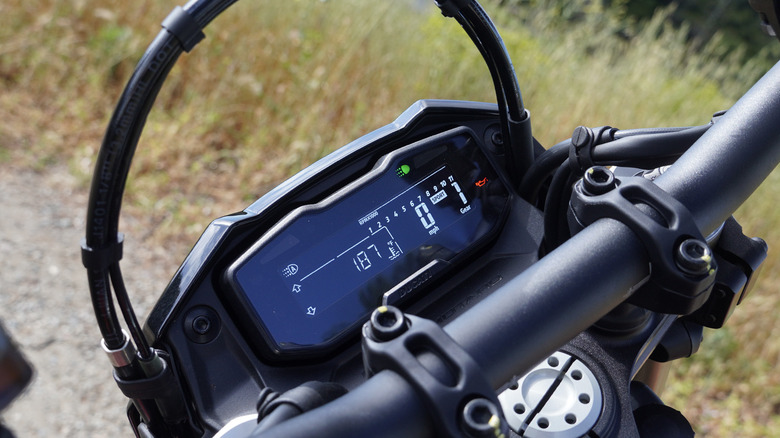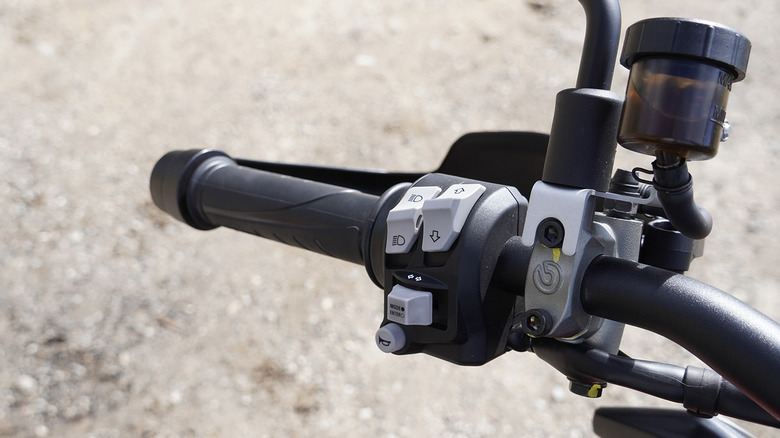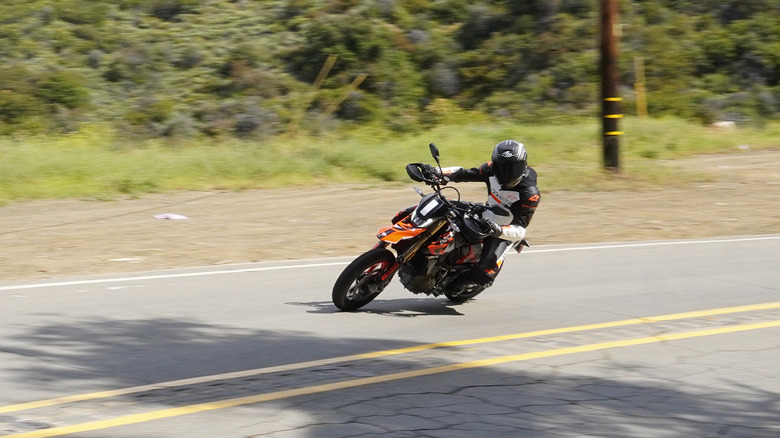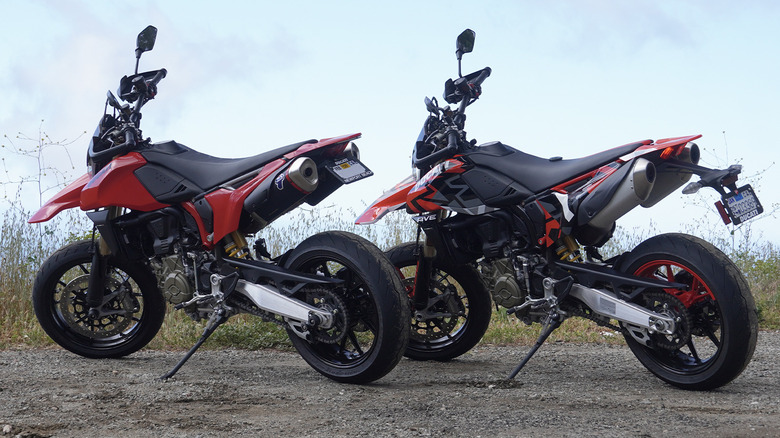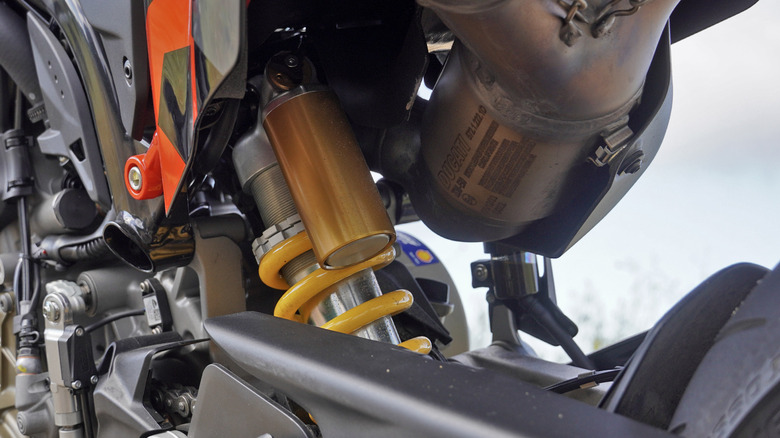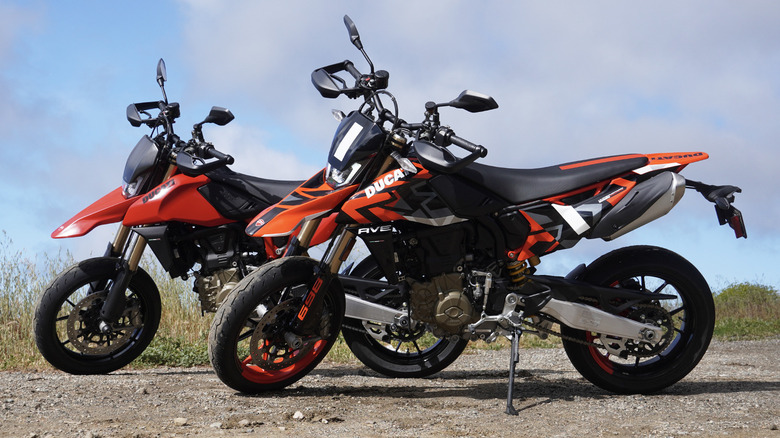2024 Ducati Hypermotard 698 Mono Review: The Winner Nobody Saw Coming
- The most powerful, highest-revving single-cylinder engine ever
- Weighs only 333 pounds
- No other bike delivers more fun
- Still not quite cheap
- Small gauge screen
- RVE or solo quickshifter decision
The Hypermotard 698 Mono somehow arrived straight out of Ducati's left field. Sure, the recent additions of the lightweight DesertX adventure bike and Desmo450 MX motocross racer might have hinted at a sea change in Bologna, but still, nobody saw a 659cc single-powered supermotard coming (or anyone who claims otherwise needs a valve adjustment, anyhow). But that little single-cylinder engine lays claim to two world bests: the most power and also the highest redline of any production single ever.
A world-beating combination of power and personality meant that the 698 Mono might potentially live up to Ducati's standards, but most importantly, using a motor that's essentially half of a 1299cc Panigale V2's helps to shed serious weight. All in an aggressively styled package complete with the a full suite of modern electronics? Calling the Hypermotard 698 Mono one of the most exciting and anticipated bikes of 2024 (not to mention one of the lightest) requires absolutely zero hyperbole, so I took a loaner curious whether any bike at all can possibly live up to such lofty expectations in the real world.
The most powerful single-cylinder yet
Developing the Superquadro Mono single-cylinder engine required less investment from Ducati precisely because the Panigale V2 already refined the package. Using Desmodromic valves, the single now produces 77.5 horsepower and 46 lb-ft of torque, while revving up to 10,250 RPM. Ducati claims that 70% of that torque hits at just 3,000 RPM. Using magnesium engine covers and aluminum cylinder sleeves sourced from the 1299 Superleggera, versus the steel components on a "regular" Panigale, shaves further weight, while a pair of balance shafts in the crankcase help to reduce vibrations from the thumping single piston.
The Mono also arrives with an optional RVE package that includes graffiti-style livery and, more importantly, an up-down quickshifter. An RVE adds $1,500 to the base bike's $12,995 price tag, but that still slots in well below the Hypermotard 950 at $18,995. The 950, predictably, puts out far more grunt at 114 horsepower and 71 lb-ft of torque, but also weighs about 100 pounds more, so the Mono manages a similar power-to-weight ratio.
Small upgrades for the RVE package
My loaner arrived in that RVE spec, of course, because Ducati only wants the press to ride the latest and greatest (and most expensive). I kind of dug the livery, but prefer the matte red of the base bike. Yet even just a few blocks from my garage, I already knew the quickshifter was a must-have. Not that the light clutch action leaves anything on the table, more that ripping through gears as quickly as possible perfectly matches the Mono's personality. Luckily, Ducati will also sell the quickshifter separately for about $285 (plus labor to install and unlock the ECU to use).
By the time I reached Malibu on my first longer ride, the sneaking suspicion already started to worm into my brain that this just might be the single best bike for tighter canyon carving. The little 659cc engine puts out just enough power to rip through traffic, and the bike rides so nimbly that lane-splitting in tight traffic seems absolutely trivial. Off the line, a quick launch—though not using the launch control—easily sent the rear suspension into a deep squat, lifting the front tire off the ground unless I shifted my weight well forward on the long, not-quite-flat seat. If I scooted back and yanked up on the handlebars, wheelie control kept the front lift from getting absurd.
Progressive, predictable power
Into the hills I turned, and in this case, on an adventure with a good friend who placed an early pre-order as soon as Ducati revealed the Hypermotard 698 Mono back in November of 2023. He also preferred the regular red paint job, so his bike eventually arrived—actually quite promptly—without the quickshifter. But he's a better rider anyway, so any advantage in pace on my RVE evaporated as we just goofed around, brapping up the canyons hitting redline, redline, redline.
Doing so never borders on scary, because the Mono's power delivery builds in progressive fashion up toward the high RPM range. With a quick twist of the wrist, a slight warble at lower revs transitions to a machine-gun chatter as the engine winds up; I regularly forgot that the redline approached, which left me lurching forward once fuel cutoff hit. The little mill just feels so happy, though unfortunately, as usual hitting the redline causes the quickshifter to balk and I then needed to pull in the clutch to move up a gear.
Finding flow on the Mono
We fell into a flow pretty quickly, though, never needing to worry about the road getting sketchy with dirt or debris from recent storms because — even as an entry-level Ducati — the Mono comes with a full suite of electronic aids. Plus, as delivered, the Marzocchi forks and Sachs rear suspension toed the line admirably between firm and predictable, with the perfect amount of front-to-rear (or, more commonly, rear-to-front) weight transfer to keep my mind on tire traction entering corners when I started to lean over.
By the time I adjusted to the high seat, so similar to the dirt bikes of my early years, the high handlebars seemed absolutely natural, too. Even while starting to lean deeper and deeper into corners, keeping weight off my wrists but countersteering just a tad, I mostly used my hips to shift the Mono's minimal mass around. The bike just laughed as I pushed through tighter and tighter corners than I expected something so upright to manage, then hauled away gleefully jumping through relatively short gear ratios, which maximize wheel torque.
A minimal adjustment period
I kept wheelie control on through the canyons, and despite reaching full throttle an almost irresponsible amount of the time, the Mono just took everything I threw at it, no problemo. At 6'1" with long limbs and about 175 pounds, my own mass plus gear made for probably more than half the bike's total fueled weight. I stood up on the square pegs a few times just to test, but mostly slid around sideways with my hips, in a low sumo-style squat that nevertheless felt comfortably planted.
Usually, lower handlebars help me adjust to motorcycles faster since I ride road bicycles more often, but in this case the Mono's tossable nature helped me acclimate with surprising speed. My friend even wound up taking his to a track day at Streets of Willow, a tight and technical circuit perfectly suited to this lightest of Ducatis—so much so that he felt happier riding there on the Hyper Mono than on his Panigale V4 R.
Getting hyper with it
By the end of my week with the Hypermotard 698 Mono, that level of comfort almost bordered on obscene. I kept fighting the lusty urge to go out for a quick ride, since even just a spin around the neighborhood brought immediate grins to my face. Where I started out in Urban mode, after a few trips up to the canyons I just stayed in Sport. And that hooligan spirit stayed strictly unavoidable. This is the only bike where I've wanted to pop wheelies, just wiggling my hips to steer, though I can admit that I never quite tested the nifty Slide-by-Brake feature of the rear wheel ABS. Not my bike, and not off a track, anyway.
I found that despite my own predilections for low and tight sport bikes, the increased suspension travel and eager weight transfer actually helps the Mono maintain that appetite for aggressive riding. In town, speed bumps become jumps and rough roads turn into rally stages. Even when the forks or rear shock get near full compression, the bike just tip-toes around because the mass to overcome the damping simply doesn't exist. Even the single front brake disc, at 330 millimeters in diameter with a budget-minded Brembo M4.32 caliper, still gets the job done for this featherweight.
Comps to the Hypermotard 950
In the name of science, I also took the time to borrow a friend's Hypermotard 950 for a bit of context, figuring I needed to more fully comprehend the exact differences between the bigger and smaller siblings. Even on just a 20-minute loop, the radically divergent characters of the two stood out. Where the 698 wants to spin and rev and rip around, the 950 delivers a deep roar of bass from within. The riding posture of both might resemble each other, but the additional mass creates a much more substantial sensation that the 950 prefers to cruise around in straight lines rather than cornering. I gave back the key 100% certain that of the two, the 698 Mono delivers a much more desirable level of fun factor—and at a lower price. Just don't ask why it's not called a 659 Mono...
I can say without question that the Hypermotard 698 Mono is one of my top two favorite new motorcycles I've ever ridden (along with the Aprilia RS 660, for those wondering). I'd spec mine in the base red, swap on a set of Termignoni pipes for the eight-horsepower gainz and a bit more soundtrack, then install the quickshifter myself to save a few bucks before paying the dealer to unlock the ECU capability. I also wonder about an aftermarket single exhaust—the dual pipes look cool but we're still talking about just a single cylinder.
2024 Ducati Hypermotard 698 Mono Verdict
Before I returned the 698 Mono, I begged desperately for Ducati to let me hold on to it for a little longer. Or even forever. Please? Because even for an affordable Ducati, we're still in Ducati territory and therefore well outside my own budget. Yet the urge still hits regularly, that maybe with a low interest rate loan I should just buy one. After arriving so far out of left field, the Hypermotard 698 Mono gripped into my brain that much, and I love speculating about just how much the positive response may help Ducati continue to develop that single for other applications (including future dirt bikes).
Best of all, the Desmo service interval for a valve clearance check clocks in only every 18,000 miles, with oil changes every 9,000 miles. Even as easy as the Mono is to live with, being quite possibly the perfect commuter or canyon carver or even track bike, putting on that many miles might well take years. No, longer trips on the Mono don't sound great, since as with most thumpers, the single piston can get a bit buzzy during steady-state highway riding. And the minimalist gauge cluster could be a bit bigger. But I still believe this Hypermotard delivers everything you need and nothing you don't. It might just be the closest thing yet to a true one-bike solution.
